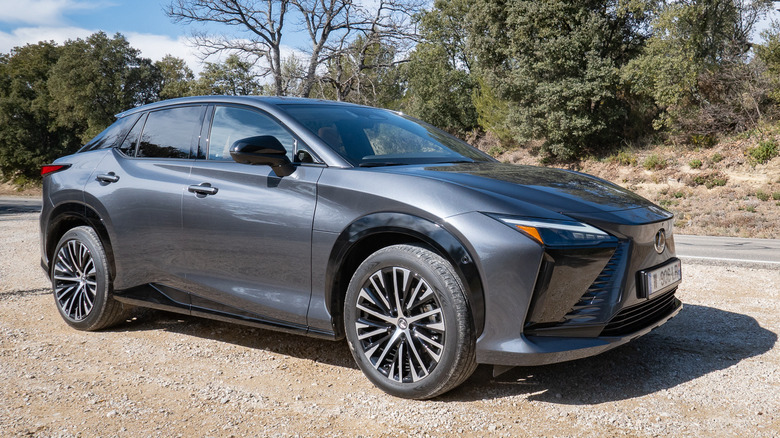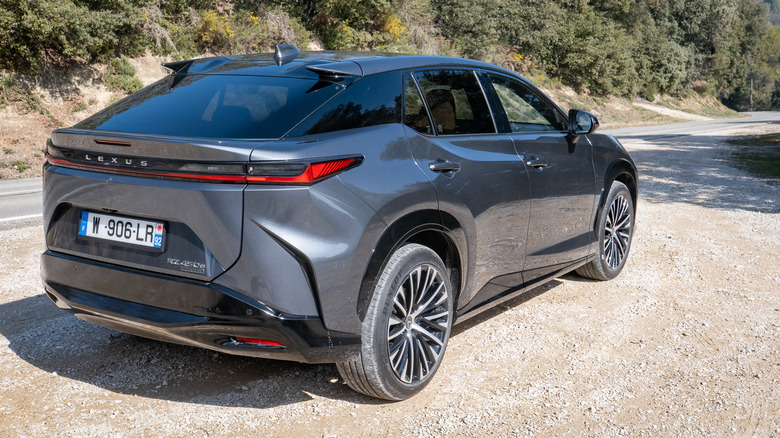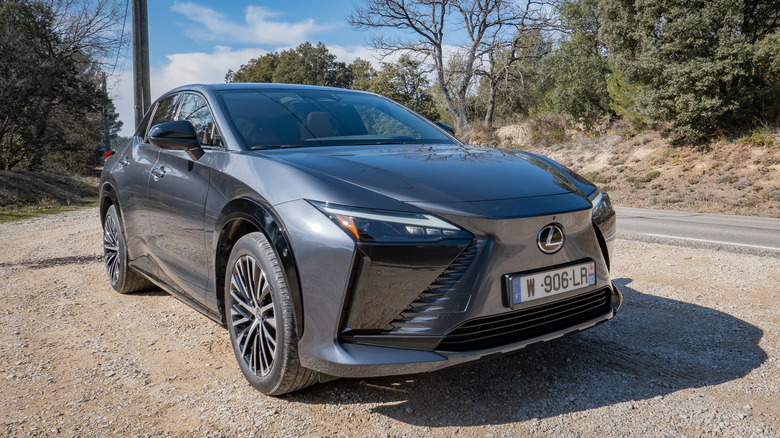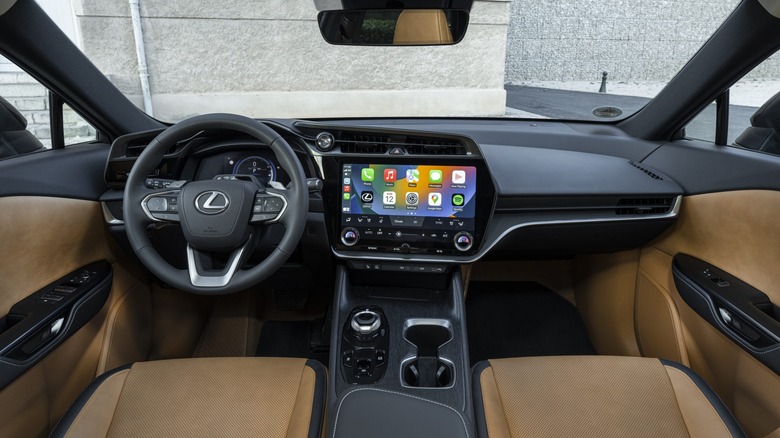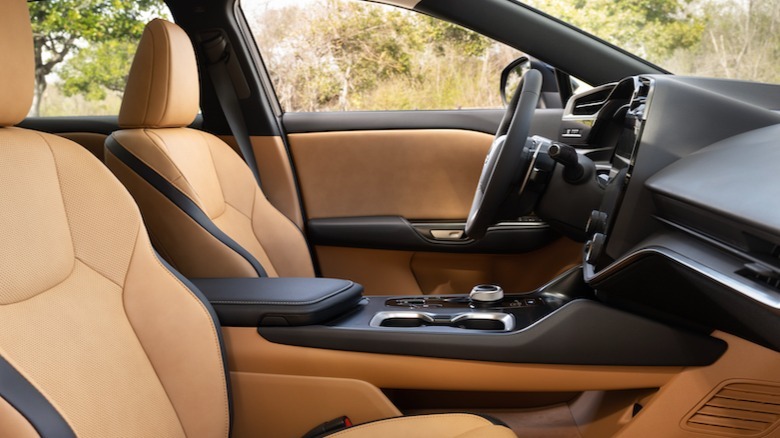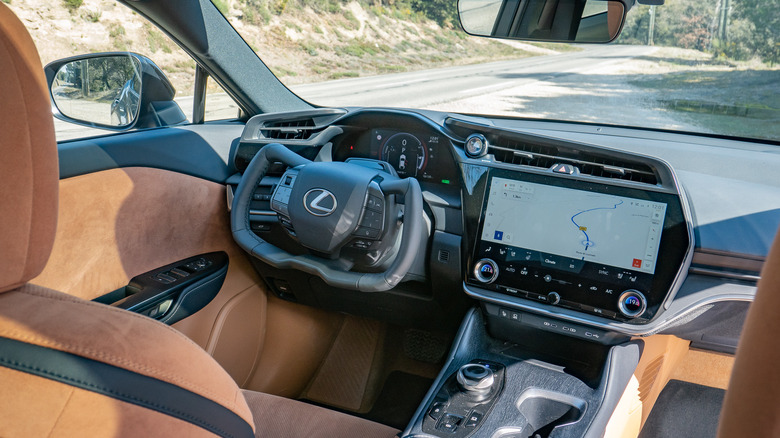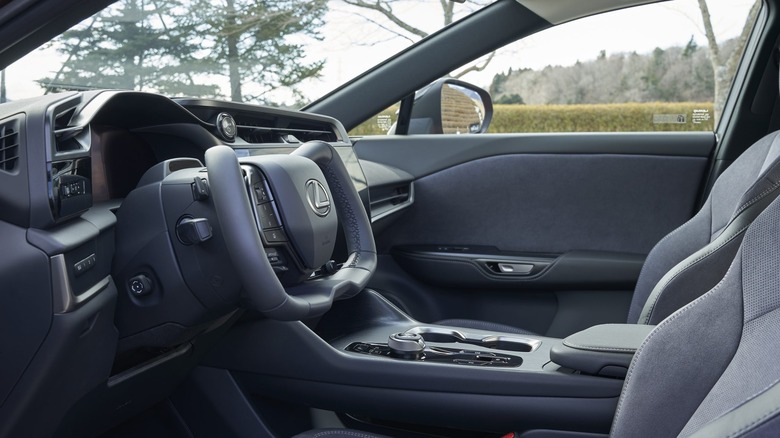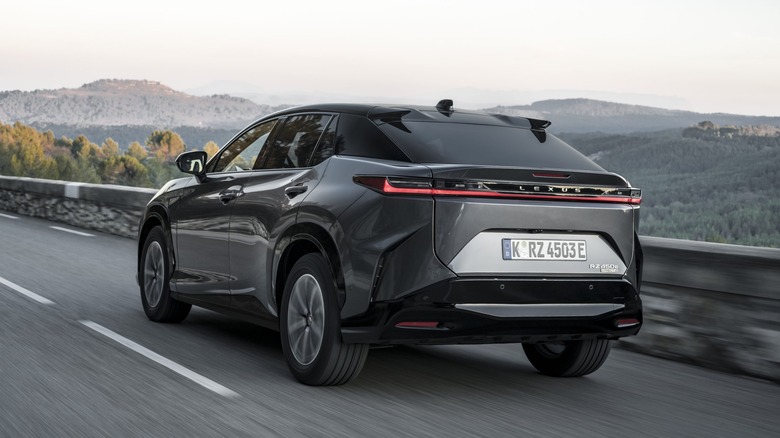2023 Lexus RZ 450e First Drive: Electric SUV Offers More Than Just A Clever Yoke
It is impossible to write about driving the new 2023 Lexus RZ and not dedicate some time to steer-by-wire, the new, yoke-controlled steering system from Lexus. But since that won't be an option on the RZ until after its launch, we'll start with the car itself — the one you'll actually be able to buy, with a regular steering wheel that is physically connected to the front axle, this year from $59,650.
The RZ is the first pure-electric car from Lexus, in that it is not available as a hybrid or with an internal-combustion drivetrain. It shares the same platform as the Toyota bZ4X, and the overall look of the two cars is quite similar despite the near-$20,000 price premium the Lexus holds over its relative.
Helping to justify that gulf is how the up-market Lexus comes in a dual-motor configuration as standard. Together, these two motors produce a healthy 313 horsepower, with 204 hp going to the front axle and 109 hp headed rearwards. Lexus' Direct4 system sends power wherever it is needed, seamlessly switching the RZ between front, rear, and all-wheel-drive configurations depending on what's needed, all in a matter of milliseconds.
Performance and range
Almost all electric cars are quick off the line, and despite not claiming to be a sports car the Lexus RZ is no exception. 0-62 mph arrives in 5.6 seconds, 2.0 seconds quicker than the Toyota. Unsurprisingly, then, it feels rapid in town and, while it's fun to accelerate out of junctions or onto the freeway, the RZ's refinement is what matters. The cabin is remarkably quiet, with no obvious sound coming from the electric motors and a wonderfully smooth ride (albeit on the favorable French roads of our test route). There's a bit of a thud when tackling speed bumps, but the RZ otherwise retains the excellent composure you would expect from a Lexus.
It also performs well in the efficiency stakes. Lexus says the RZ will manage 3.3 to 3.7 miles per kWh, but we managed to average 4.0 after 75 minutes of normal driving.The route lacked highways though, so a long stint at higher speed will surely see that efficiency figure fall, as with all EVs.
Lexus states a targeted range of 220 miles for the U.S. market with the standard-fit 18-inch wheels, though it expects most buyers to pick the optional 20-inch rims. These, Lexus says, could reduce range by as much as 25 miles. We suspect the 200-mile estimate is conservative, as our 4.0 m/kWh average multiplied by the usable battery capacity of 64 kWh (from a 71.4 kWh total) suggests as much as 250 miles could be possible.
When it comes to recharging, there's 150 kW DC fast-charging support. Lexus says you could go from 0-80% in around 30 minutes.
Ride and handling
We already said how the RZ's ride is pretty impressive, but it's worth reiterating here because the cabin really is a quiet, calm and relaxing place to be. We're not quite talking Range Rover levels of refinement here, but the Lexus certainly serves up the sort of hush you actually notice. The lack of obtrusive synthetic engine sound effects, apart from when accelerating firmly, is to Lexus' credit, and the RZ is all the better for it.
The brakes are aided by three levels of regenerative braking, adjusted using paddles behind the steering wheel. While the regen works mostly as expected, we'd like to see the strongest level work even harder, as the RZ doesn't feel like it can be driven in the one-pedal manner of other EVs.
We suspect this more restrained approach is intentional, given how the RZ will likely be bought by existing Lexus drivers as their first electric car. This feeling is replicated throughout, from the exterior styling to the interior, where there's a sense Lexus wanted the RZ to slot neatly into its existing range, between the NX and larger RX, rather than sit alone as an attention-grabbing EV debut.
Interior and infotainment
Speaking of the interior, Lexus owners will feel at home pretty quickly inside the RZ. There's a calm simplicity on show here, with switchgear exactly where you expect it to be and plenty of physical, tactile buttons on the steering wheel — none of the frustrating haptic touch controls used by other brands. The dashboard is dominated by a huge, 14-inch touchscreen display that runs wireless Apple CarPlay and Android Auto. The way it protrudes from the dash — flat-fronted and angled noticeably towards the driver — it feels a bit like Lexus has somehow crammed an old CRT television in there. It lacks elegance, in our opinion, but there's no disputing that its size and position makes the system easy to see and use.
Interior highlights include ambient lighting that is projected into patterns on the door cards, which looks great, and so-called radiant heating that aims to warm the front-seat occupants as if, Lexus says, they have "a warm blanket wrapped around their legs." There's also a panoramic roof with glass that can be tinted with the press of a button.
Device charging is well catered for, with three USB-C ports and a wireless charging pad below the touch screen. Visibility is good and there's a decent amount of space for rear passengers, although three adults abreast would start to feel cramped.
Steer-by-Wire aka One Motion Grip
Here we go, then: let's talk about the steer-by-wire system, branded "One Motion Grip" in European markets. This is a fly-by-wire system where the wheel/yoke sends a signal to an electric steering rack, which then turns the front axle. There is no physical connection between your hands and the road, brakes, and tires, so all the feedback and resistance you feel is augmented by a second motor attached to the yoke.
This approach means Lexus can offer a variable steering ratio, where how much the wheels turn for each degree of steering input can change depending on factors like vehicle speed and the speed of the driver's inputs. The result is a yoke that turns just 150 degrees, yet the wheels turn as much as any other car, so your hands need never leave the quarter-to-three position.
It takes some getting used to. Our first couple of miles were filled with the jerky, correction-filled steering inputs of a learner driver on their first lesson. The need for a sudden relearning of the most basic of car controls (and to locate the shortened turn signal stalk) takes a fair bit of mental recalibration. But after a half-hour we began to get the hang of it. The system makes parking maneuvers and tight, slow turns easy, while feeling fairly conventional on the highway and offering an improved view of the instrument cluster, which is higher and further away than in the regular RZ.
Has Lexus reinvented the wheel?
It's hard to say at this stage. Lexus has said that European markets will get One Motion Grip as a production option from 2025, while in the U.S. it's on the roadmap but with no specific launch date attached. Either way, it still has plenty of time for refinement. We have no doubt that time will see it improve, but for now it feels like a solution in search of a problem.
Do any drivers actually complain about having to deploy a bit of hand-over-hand steering in the parking lot? Some cars are guilty of partially blocking the instrument cluster with their own wheel (Porsche Taycan, we're looking at you), but does that warrant an entire new steering system? Lexus says drivers will benefit from being "shielded" from the vibrations of the brakes and tires, but the regular RZ hardly dishes out Caterham levels of feedback, and certainly not enough to make us beg for less.
It looks cool, and we applaud Lexus for sinking a whole heap of resources into making its first pure EV stand out from an increasingly identikit crowd. But we think the tech would be far better-placed in a sports car, like the electric two-seater Toyota has planned as a spiritual successor to the MR2 later this decade.
2023 Lexus RZ 450e Verdict
Back to the RZ with conventional steering, and there's plenty to like. We were impressed by its refinement, efficiency and range, while the sharp-suited exterior will appeal to fans of recent Lexuses without alienating buyers with an aesthetic that screams 'look at me, I'm electric'.
It may be a little late to the full-EV game, but now Lexus has arrived it's equipped with a worthy rival to the likes of the Audi Q4 e-tron, Mercedes-Benz EQB, and Tesla Model Y We still have questions about the steer-by-wire technology, and whether any car really, truly benefits from such a system. But Lexus should be credited for trying something new, and in a way that feels far more considered than the Tesla Model S Plaid, which has a yoke but lacks the RZ's steer-by-wire and variable steering ratio cleverness.
Sales of the 2023 Lexus RZ begin in the U.S. today, albeit "in limited quantities" according to the automaker. The RZ 450e Premium AWD starts at $59,650 (plus $1,150 destination) with 18-inch wheels, or from $60,890 (plus destination) with 20-inch wheels. The RZ 450e Luxury AWD starts at $65,150 (plus destination).
